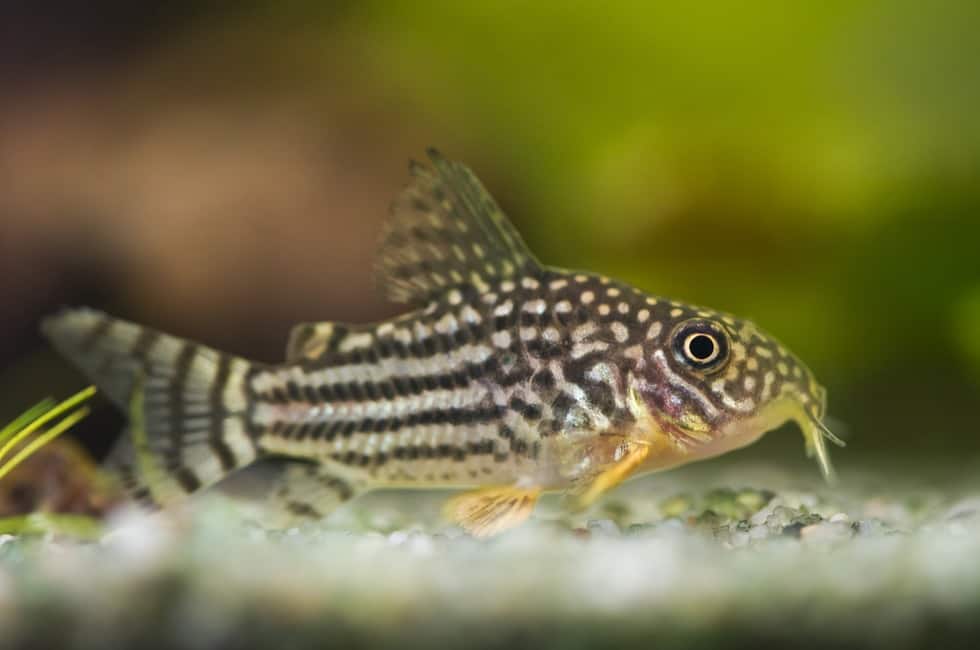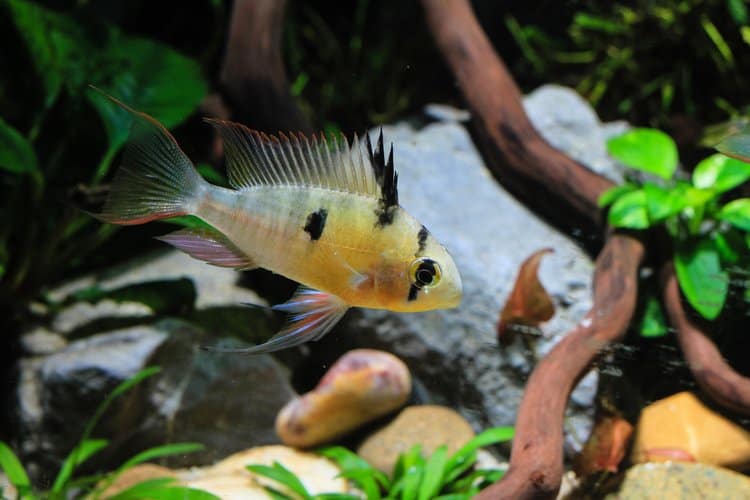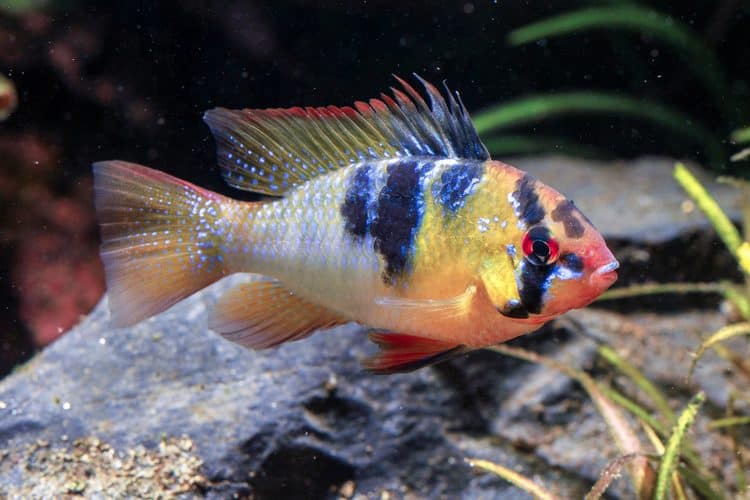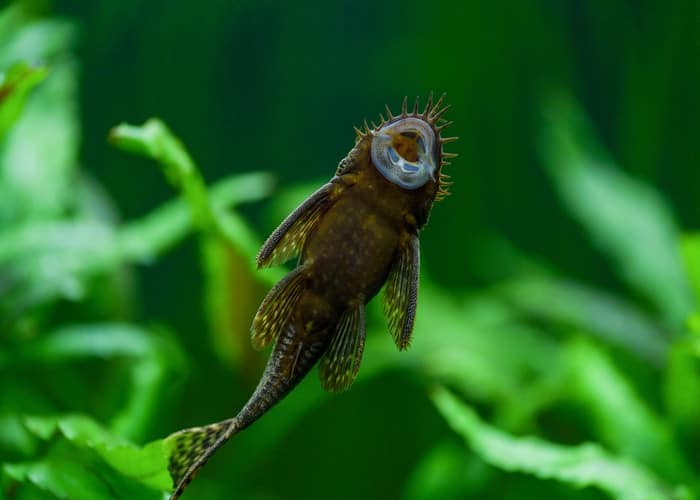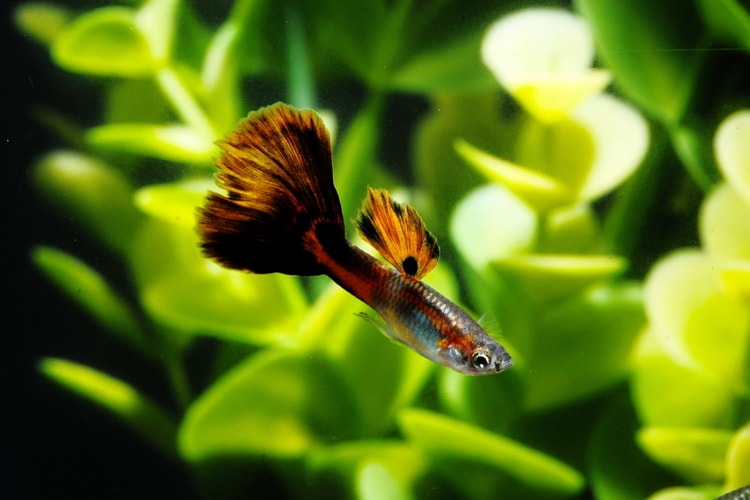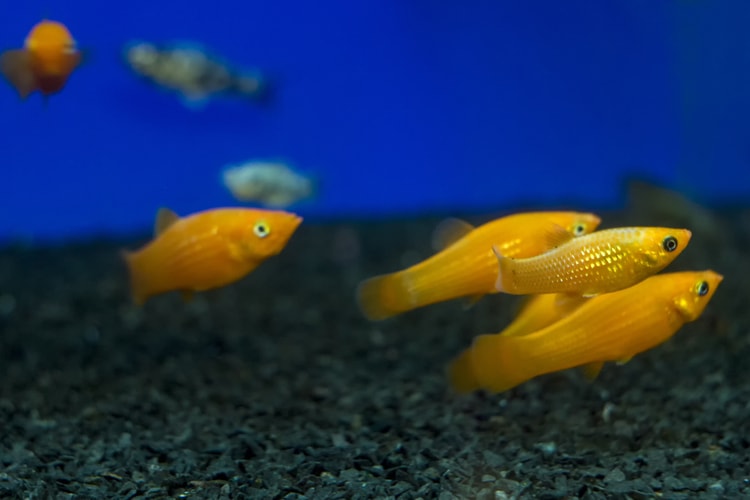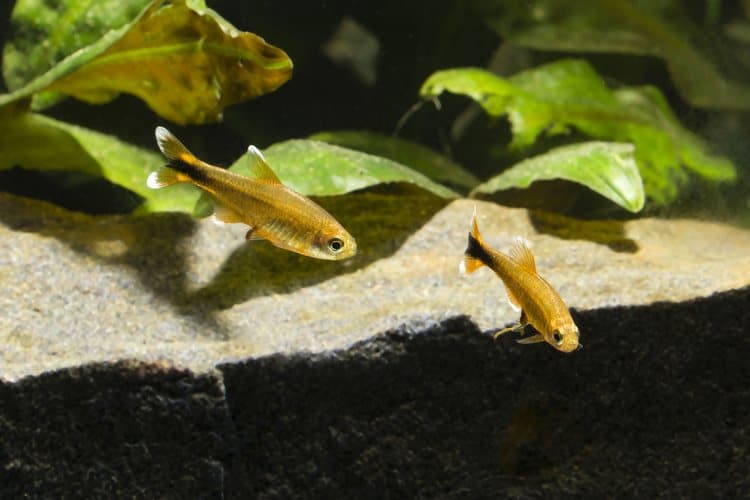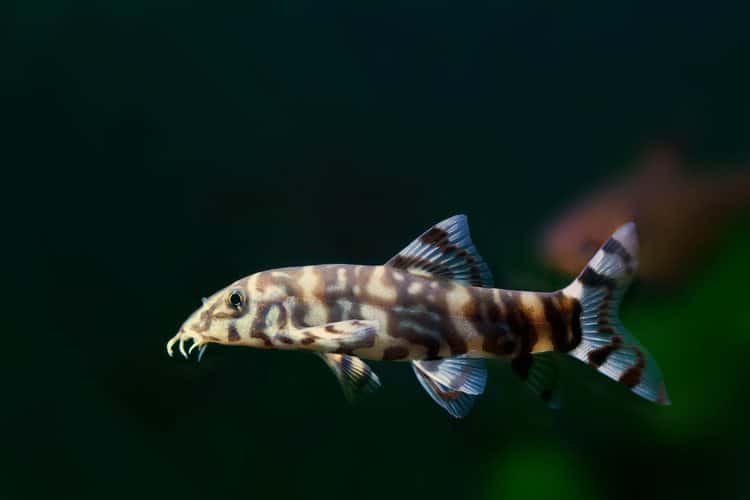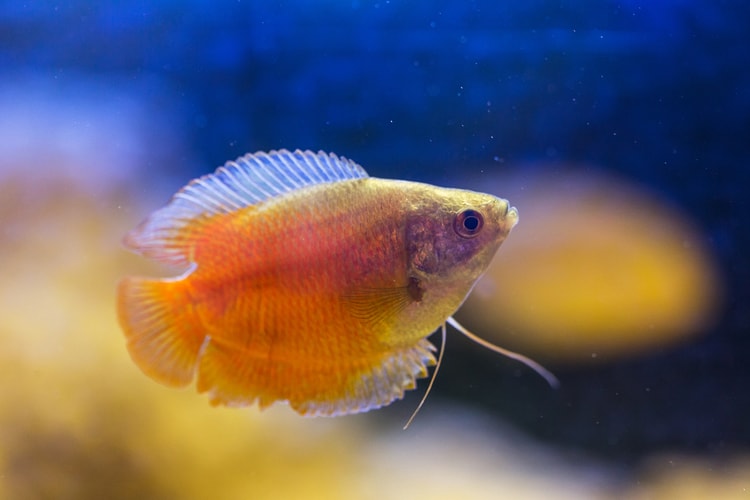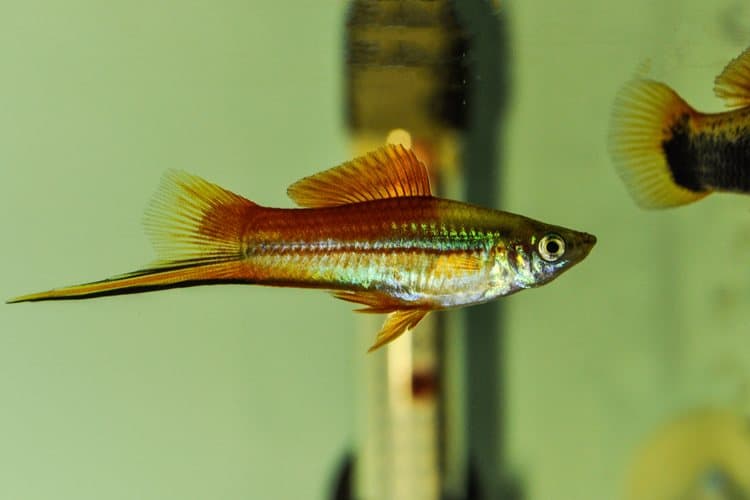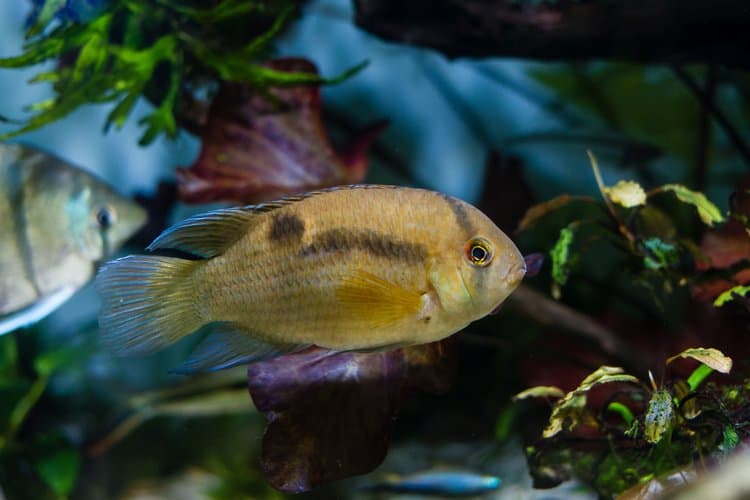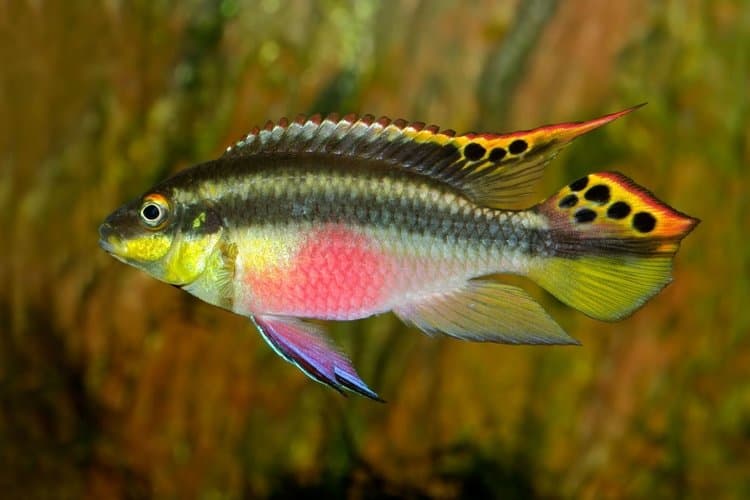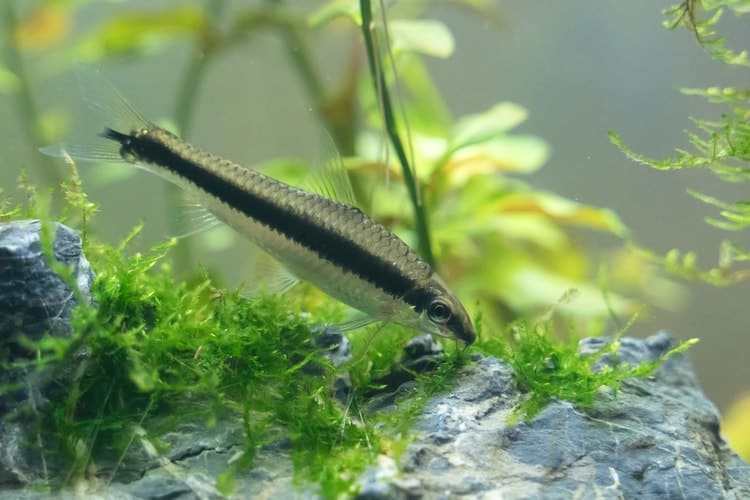Angelfish are some of the most alluring fish and most hobbyist can attest to this. However, choosing the ideal tank mate(s) becomes a daunting task. If you are not sure of which fish to introduce in the tank, then this article is for you.
Which are the best tankmates for angelfish? Angelfish is compatible with numerous fish among them rams and barbs. Introduce tank mates that are of the same size or slightly larger than angelfish. Angelfish are natural predators and will devour any small fish they find. Keep them in a large aquarium.
Well, to avoid unforeseen nipping and aggression in angelfish, we recommend the following tank mates. So, let’s talk turkey and have a look at these angelfish buddies.
Angelfish Tank Mates List
1. Corydora Catfish
- Temperature: 22-26 C
- Size: 2.5 inches
- Lifespan: 5 years
- Tank size: 10+ gallon
As far as angelfish tank mates are concerned, Cory catfish is the best compatible fish. They are peaceful, timid and calm. They prefer thriving in groups, so we recommend keeping them in groups of 5-6. They are naturally bottom dwellers are will consume what is in the substrate.
In fact, they rarely come into contact with angelfish, since angelfish are middle dwellers. Cory catfish predominantly feed on sinking pellets, flakes and tablets. Avoid overfeeding them to avoid complications such as swim bladder disease. In fact, feed them with the amount of food they can devour in 5 minutes.
They are most active during the day scavenging whatever they find at the bottom. However, they can relax resting motionless on the same spot. Cory catfish are easy to handle therefore suitable for novice hobbyists.
2. Bolivian Rams (Mikrogeophagus Altispinosus)
- Temperature: 23-28 C
- Size: 2 inches
- Lifespan: 6 years
- Tank size: 44+ gallon
The next most ideal tank mates are Bolivian Rams. They are small, peaceful and appealing cichlids that live peacefully with angelfish. Compared to ram cichlids, they are slightly aggressive but upon comparing them with the larger family they are peaceful.
They prefer a community aquarium, therefore, keep them in groups of 5-6. Bolivian Rams primarily dwell on the bottom of the tank and because of this, they are less likely to cross roads with angelfish. Their small size also contributes to their compatibility since there’ll be no overcrowding.
Ensure that the tank is heavily planted to make them happy. In fact, they’ll be begging for more shelter as they age. What about the lighting?
They prefer traces of dim light. To achieve this, introduce floating decorations. Bolivian Rams are easy to keep and guess what? They can tolerate some mistakes such as high temperatures or slightly dirty water.
3. Platies
- Temperature: 22-26 C
- Size: 2.5 inches
- Lifespan: 3-4 years
- Tank size: 15+ gallon
This is one of the most common aquarium fish that has numerous tank mates among them angelfish. They are beautiful, have numerous color patterns that get you hooked as it swims. Moreover, they are active swimmers and breed rapidly.
Conversely, they prefer densely planted tanks where they can hide as they rest after a “tiresome” day. They are easy to keep hence a perfect choice for novice hobbyist. Additionally, they are hardy fish that can tolerate slight mistakes in the tank.
Their diet is not demanding since they are omnivorous. You can feed them with pellets, vegetables, flakes, and vegetables. Once in a while treat them with blood worms and shrimps.
Interestingly, most hobbyists prefer keeping platies and angelfish together? Why? Platies breed rapidly and angelfish feed on their young ones keeping the platies popular in check. Funny, isn’t it?
4. German Rams
- Temperature: 26-30 C
- Size: 2.7 inches
- Lifespan: 2-3 years
- Tank size: 20+ gallon
Want to add some aesthetic touch to your aquarium? Well, German Rams are the right fish to keep. They are brightly colored, attractive creatures that like to display their alluring bodies. They are difficult to keep hence not ideal for beginners.
Naturally, they are peaceful fish that prefer dwelling at the bottom of the tank like their counterparts, Bolivian rams. Therefore, they rarely come into contact with angelfish. We recommend feeding them with a diverse diet since they are omnivores. Pellets, flakes, vegetables, and frozen or live mosquitoes and insects are the most ideal.
Female German rams are smaller than their male counterparts and exhibit a pink pigmentation. For them to thrive, you need to change the water often, install filters and make sure the water is slightly still.
5. Bristlenose Pleco
- Temperature: 15-27 C
- Size: 5 inches
- Lifespan: 5+ years
- Tank size: 25+ gallon
Bristlenose Plecos are some of the most common plecos preferred by fishkeepers. They are small, peaceful and stellar tank cleaners – they literally clean the tank. They are bottom dwellers that scavenge whatever they find in the substrate.
Their bizarre-looking appearance makes them a preference for most hobbyist. They are flat, fat and have a wide head. Upon reaching maturity, they sprout branches that look like tentacles are their head. They tend to be lazy since they stay motionless for long periods of time.
These plecos are very hardy and easy to keep therefore they can thrive in different tank conditions without needing much maintenance. However, do not keep two males in one tank because they are extremely territorial fish. Moreover, they have body armor that can easily harm their competitors.
6. Cherry Barbs
- Temperature: 20-26 C
- Size: 2 inches
- Lifespan: 5-6 years
- Tank size: 25+ gallon
These brightly colored barbs are a preference by most hobbyists. This is because of their schooling nature and their ability to thrive with angelfish. As such, we recommend keeping them in groups of 5-6. Although compatible with angelfish, you should keep an eye on the tank since there might be cases of nipping and aggression.
Cherry barbs prefer densely planted tanks which provide them with much-needed hiding places when threatened. Especially the female – males tend to attack females during breeding. When in a group, they are confident enough to swim around the surface and middle level unlike when alone – they are shy and tend to hide from tank mates.
For them to remain brightly colored, you ought to keep water conditions optimal and keep the lighting low. Some of the most recommended plants include java fern and Hornwort.
7. Guppies
- Temperature: 20-26 C
- Size: 2.4 inches
- Lifespan: 2 years
- Tank size: 5+ gallon
Guppies are some of the most common aquarium fish. They are colorful, easy to keep and hardy fish. This makes them ideal for beginners and professional fishkeepers.
However, introduce them in the tank when angelfish are still young. In so doing, they’ll see angelfish will see them as tank mates and not potential food.
When it comes to appearance, the male dominates the female in that it is more colorful and good looking. Females are way duller and not appealing to the eye. They are omnivores hence feeding them is not a fuss. Feed them with pellets, flakes, live insects, vegetables, etc.
They are very active small fish and tend to breed rapidly. In fact, the male usually chases after females in a bid to impress them and lure them into breeding.
8. Kuhli Loach
- Temperature: 24-30 C
- Size: 4 inches
- Lifespan: 10 years
- Tank size: 20 gallons
Kuhli loaches are peaceful bottom dwellers that burrow in the sand looking for something to devour. It is sand and not gravel. Gravel tends to hurt their fragile bellies.
They are extremely active during the night and evenings. In fact, you can hardly see them during the day since they spend much of their day hiding.
However, if kept in a group or with several other fish, they become extra active, maybe because they view them as food rivals. To facilitate their hiding behavior, make sure there are plenty of hiding places in the tank.
They are omnivores hence feed on a diverse diet. You can feed them with flakes, pellets, vegetables, frozen blood worms, and shrimps. Their downward pointing mouth is surrounded by four pairs of barbels.
9. Mollies
- Temperature: 22-26 C
- Size: 4 inches
- Lifespan: 5 years
- Tank size: 20+ gallon
Many hobbyists swear by mollies since they make perfect tank mates for angelfish. In fact, mollies are well adapted to protect themselves from any attack from angelfish. They are hardy fish and thrive in tough water conditions. Moreover, some types of mollies thrive in salty water.
They are peaceful and very colorful. However, there can be cases of nipping but when kept in groups they rarely bother their tank mates. The downside of keeping mollies is that they are very delicate and prone to diseases. Therefore, they are not ideal for novice hobbyists.
They are considered omnivores, therefore, a varied diet will be ideal for them. Feed them with flakes, vegetables, and algae. You can always supplement their diet with blood worms and brine shrimp. On average feed them at least two times a day.
11. Tetras
- Temperature: 22-26 C
- Size: 2 inches
- Lifespan: 10 years
- Tank size: 20+ gallon
Tetras are small tropical fish that are beautifully colored and easy to keep. As such, they are common among fish keepers. Feeding these fish is not demanding since they are omnivores. Their peaceful nature makes them ideal tank mates for angelfish.
They are schooling fish that spend most of their time in groups of 5-6 fish primarily swimming in the middle of the tank. There are different types of tetras not limited to neon tetra, black neon tetra, cardinal tetra, and emperor tetra.
They prefer densely planted tanks and gravel as a substrate. Also, consider putting decorations with ample hiding places.
12. Yoyo Loach
- Temperature: 22-26 C
- Size: 2.5 inches
- Lifespan: 5-8 years
- Tank size: 20+ gallon
They are very brightly colored fish that bring life to your tank. They display dark bands with light blue tints which contrast against their silver bodies. Well, this adds an aesthetic touch to your aquarium. Yoyo loaches are generally peaceful but are known to fight members of their own species if threatened.
However, they are overall peaceful when kept together with other tank mates. Given their small size, it is advisable that you keep them in groups of 5-6. This way, they’ll rarely come into contact with angelfish. Additionally, keep them in large tanks together with angelfish.
They are very active during the day and will spend much of their time looking for food. What about their diet? Well, naturally they are scavengers and will feed on whatever they find. As such, feeding is to a fuss. Having said that, you can feed them with sinking pellets, flakes, and wafers. They are ideal for novice hobbyists as well as professionals.
13. Dwarf Gourami
- Temperature: 22-26 C
- Size: 4 inches
- Lifespan: 5-10 years
- Tank size: 20+ gallon
These colorful fish are popular among hobbyists. Their colorful bodies add a much-needed aesthetic touch in the aquarium. They are very shy and peaceful fish which makes them compatible with angelfish. They are easy to look after and their diet is not demanding.
Although peaceful, they are aggressive toward other Anabantoids in the tank. Additionally, aggression is viewed when they are kept in a small aquarium together with multiple males of other spices. They also tend to stay motionless for long.
Need a fish that will give attention? Then dwarf gourami is the fish to keep. They approach the side of the tank whenever the owner approaches. They prefer slow flow water to facilitate their ability to absorb oxygen from the water.
They are omnivores hence will require a diet that varies from algae-based to meat-based. As such, you can feed them with pellets, waffles, tablets, brine shrimps and blood worms.
13. Swordtails (Xiphophorus hellerii)
- Temperature: 22-26 C
- Size: 5.5 inches
- Lifespan:
- Tank size: 15+ gallon
Well, these colorful fish are a perfect choice if want to jazz up your aquarium. They come in different colors and sizes. Their elongated bottom tail gives them the name swordtail. They are peaceful in nature but can get aggressive if threatened by angelfish and other tank mates.
Always keep them in groups for optimal thriving. They breed rapidly under normal conditions. No prior preparation of the breeding ground is required. They will feed on a varied diet such as mosquito larvae, algae, fruit flies, flakes, pellets, etc.
They are quite active therefore don’t be stunned if you find it trying to jump out of the tank. Additionally, these fish are very hardy and will tolerate slight gradual changes in water conditions. However, avoid sudden changes in water as this might shock them.
14. Keyhole Cichlids (Cleithracara maronii)
- Temperature: 22-26 C
- Size: 4 inches
- Lifespan: 8 years
- Tank size: 20+ gallon
Keyhole cichlids are extremely difficult to find in pet stores. This is because most hobbyists are not attracted to their dull coloring. However, they are peaceful, clever and tend to thrive seamlessly with angelfish and other tank mates.
They have a black strip that goes across their eyes. Their undemanding nature makes them a suitable fish for novice fishkeepers.
However, you should still keep a closer eye on these fish. They prefer tanks with numerous hiding spots since they prefer spending much of their time in shelters since they are timid.
They form couples and are extremely territorial. Therefore, it would be prudent to provide ample shelters which they can use as territories. What about the diet? Lucky you, they are omnivores which means they can feed about everything; from flakes, larvae, to vegetables and pellets.
15. Kribensis Cichlids (Pelvicachromis pulcher)
- Temperature: 22-26 C
- Size: 4 inches
- Lifespan: 5 years
- Tank size: 20+ gallon
They are popular colorful fish among hobbyists. They interact with angelfish and other tank mates seamlessly without posing any aggression. They spend much of their time hiding like keyhole cichlids. Therefore, provide ample plants, tunnels, and rocks which are ideal hiding places.
They are omnivores hence should be fed with a varied diet which should be supplemented with dried food. They will devour pellets, flakes, frozen brine shrimps, blood worms, and daphnia. You can even add some vegetables in the tank which they can devour gradually.
However, avoid overfeeding them as this can lead to dire consequences such as bloating. In essence, they should devour their food in almost 30 seconds. And this should be done at least twice per day.
16. Common Pleco (Hypostomus plecostomus)
- Temperature: 23-28 C
- Size: 18 inches
- Lifespan: 10-15 years
- Tank size: 100+ gallon
Common plecos are ideal angelfish tankmates especially when they are still young. This is because they are peaceful and slightly the same size as angelfish fish at this stage. However, as they mature, they become quite aggressive towards tank mates and ultimately grow to tank busting sizes.
Nonetheless, they can co-exist with the angelfish if they are kept in 200+ gallon tank upon maturity. Another thing, keep one common Pleco per tank to avoid overcrowding. They are bottom-feeders primarily feeding on algae.
Unfortunately, as they mature they eat less of algae turning into hunters of wide-body fish. To mitigate this, supplement their diet with sinking algae wafers and pellets. The most appropriate time to feed them is during the night when the lights are off.
Overall, they are peaceful fish that are easy to care and predominantly spend most of their time at the bottom of the tank. As such, they rarely come into contact with angelfish.
17. Sailfin Molly
- Temperature: 25-28 C
- Size: 7.1 inches
- Lifespan: 3-5 years
- Tank size: 20+ gallon
These are livebearing tropical fish that make stellar angelfish tank mates just like other mollies. They are peaceful and often keep to themselves rarely coming into contact with angelfish. In fact, they thrive in the same environmental conditions with angelfish, therefore, they are extremely compatible.
Although easy to care for, they are prone to infections. As such, you should keep your water conditions optimal and observe proper tank hygiene.
Failure to this, your tank buddy get shocked, stressed which leads to a weak immune system and eventually succumb to infections.
Another thing, adding a pinch of salt into the aquarium will be beneficial for these mollies. However, ensure that the robust plant cover is tolerant of low levels of salt. Keep them in a ratio of three females for every male sailfin molly. This way, the females will not get exhausted from males’ continual sexual arousal.
They feed on a varied diet so feeding them with pellets, flakes, and frozen food such as mosquito larvae, brine shrimps and blood worms is paramount. Also, supplement the diet with vegetable-based flakes.
18. Siamese Algae Eater
- Temperature: 24-26 C
- Size: 6 inches
- Lifespan: 10 years
- Tank size: 30+ gallon
These stellar tank cleaners are also referred to as SAE. They are peaceful and slightly large fish that make stellar angelfish tank buddies.
With them, you don’t need to clean your tank or add chemicals, they’ll do the work for you. In fact, they are the only algae eaters that consume the black beard algae.
Although peaceful, they become aggressive when hungry or when they are alone in a tank with other species. As such, it is prudent to keep them in groups of 4-5 since they are schooling fish. Additionally, they are herbivorous so you need to feed them with a special diet such as algae flakes.
They prefer densely planted tanks since they rest on wide leaves. Nonetheless, if there are no wide leaf plants, they rest on the tank bottom. Ensure that there are sufficient water waves to mimic its natural habitat. In addition, keep them in groups of 5-6 for a more natural appearance and natural behavior.
19. Head and Tail Light Tetras
- Temperature: 22-26 C
- Size: 2 inches
- Lifespan: 5 years
- Tank size: 15+ gallon
They are popularly known for their coppery spots that mimic taillights. They come from the same environmental region – streams in South America – as the angelfish. They are overly peaceful fish, but prone to fin nipping especially long fins. As such it is paramount you keep a close eye on the aquarium.
Another distinctive feature is a red spot above their eyes. Keep them in groups of 5-6 since they are schooling fish. Also, ensure they have ample swimming space and subdued mood lighting is a boon. Additionally, provide floating or tall plants that provide shade.
Well, like any other omnivore, they feed on a varied diet. You can feed them with frozen brine shrimps, blood worms, and mosquito larvae. Also, pellets, flakes, and tablets will do. They are relatively easy to breed hence a perfect choice for beginners.
20. Malaysian Trumpet Snails
- Temperature: 22-26 C
- Size: 2.5 inches
- Lifespan: 1 year
- Tank size: 5+ gallon
Well, if you are looking for a stellar tank cleaner, then these snails are the top priority. They are kept by most hobbyists for cleaning purposes. They can eat entirely anything they come across from fish waste, uneaten food to edible plant waste.
However, quite a number of fishkeepers view them as pests rather than pets. This is because of their ability to breed rapidly. As such, control the number you introduce in your tank, otherwise, they’ll make quite a large colony.
These vicious eaters like staying groups so they’ll rarely come into contact with angelfish. So, if you desire to jazz up your tank with anything else other than fish, you should consider these snails.
Which Fish are Not Compatible with Angelfish?
Avoid keeping angelfish with fish that nip long and frowny fins such as some tetra species – Neon and Blackshirt. Again, for optimal co-existence, introduce tank mates when both species are still young. This way, angelfish will view them as tank buddies rather than potential food.
So which species should you avoid?
Shrimp: well, too often a shrimp will fit in the mouth of angelfish. As such, the angelfish will view them as food hunting them wherever they find them. Moreover, if the shrimp is large, the angelfish will nip at it until death
Betta fish: very territorial, they attack whatever resembles them. In fact, vicious fights will be a common phenomenon in your tank. Avoid keeping them together by all means.
Related Questions
Which are the best tank cleaners in an angelfish aquarium?
Well, you can choose from the following:
- Malaysian trumpet snails
- Siamese algae eaters
- Bristlenose Plecos
The above are the most ideal tank cleaners to keep together with angelfish. We’d recommend the Malaysian trumpet snails since they feed on everything and since they are not fish, they pose no danger to the angelfish.
Do angelfish get along with other angelfish?
Yes they do, however, during breeding the males become aggressive as they tend to push each other in a bid to impress females
Are angelfish good for a community tank?
Angelfish thrive in tanks of their own species especially in groups of 5-6. However, if you want to raise them in a community tank, you should introduce all species while they are still young. This way, angelfish will view them as potential tank mates.
Are angelfish aggressive with other fish?
Yes. Especially with goldfish, shrimps, betta fish, neon and Blackshirt tetras. Avoid keeping them with the aforementioned species. Overall, they are the perfect choice for your aquarium don’t hesitate to purchase them from your nearest pet store.
Can angelfish live alone?
Quite a handful of hobbyists have kept sole angelfish without any complications, however, this robs them of their natural instincts since they are shoaling fish. As such, keep them in groups of 5-6.
How long can angelfish live?
If kept in optimal water conditions, angelfish can live up to 10 years.
Bottom line
As mentioned above, angelfish are quite peaceful fish that thrive among peaceful to semi-aggressive fish species. You can choose from any of the above tank mates and practice caution where need be. Again, avoid keeping them with aggressive species such as betta fish.


